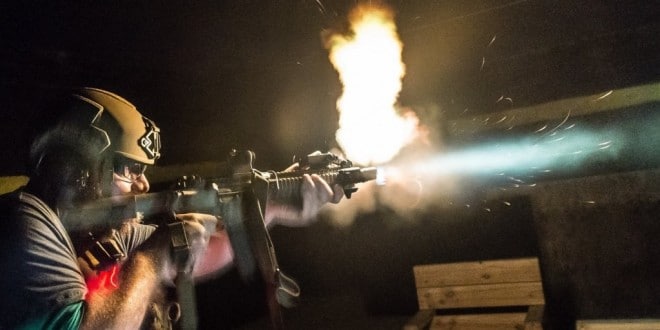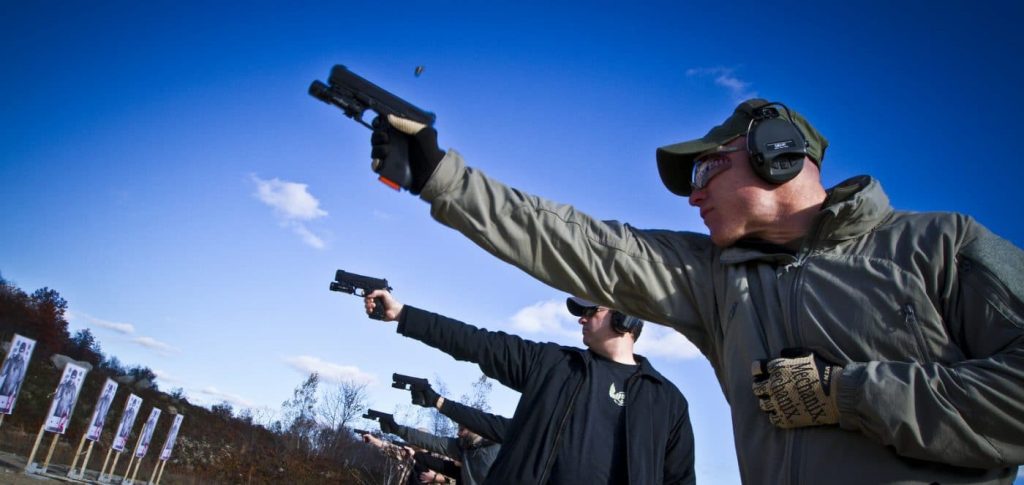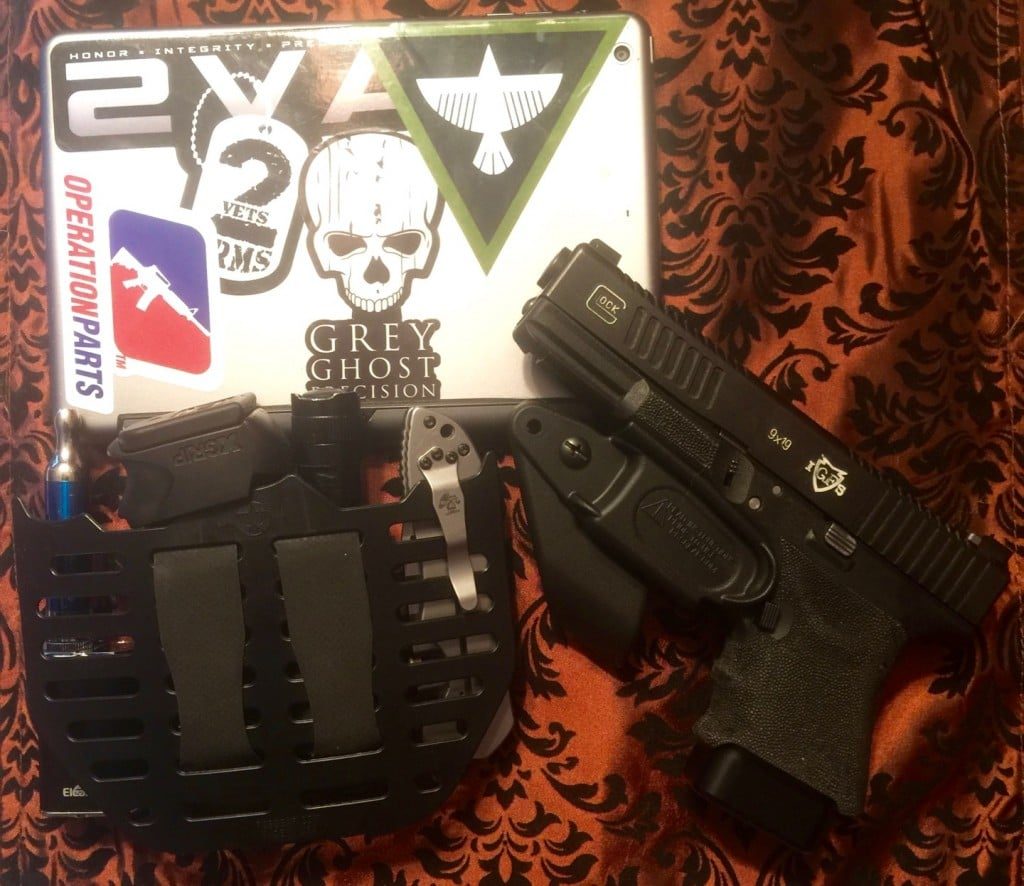
Low Light Handgun and Carbine, Sentinel Concepts AAR
As originally posted on 248Shooter.com
November 3, 2015, by Charles Anderson
Photo courtesy JWramp.com
Date: Oct 23,34 4pm-12am
Location: Alliance PD Range
Weather: Chilly on the 23rd, Pouring rain 24th
If there is one quote that sums up the class with Sentinel Concepts it’s, “You don’t know what you don’t know till you know that you don’t know it.”
Gear:
- IGFS modified G19
- Inforce APL
- Magpul GL9 Magazines
- Forest City Tactical Holster
- Tuff Products Magazine carriers
- Tuff Products EDC Belt
- 5.11 Pants
- 5.11 rain shell
- Elzetta Charlie flashlight
- Streamlight Protac flashlight
- Rudy’s Photochromatic eye pro
- Raven Moduloader Pocket Shield
- Cleer Medical IFAK
- Palmetto State Arms AR15
- Aimpoint T2
- Troy PDW Stock
- Inforce WML
- Blue Force Gear Vickers Sling
Class
The day started with the typical safety brief and low light fundamentals. We began shooting around 5 pm with the sun still up but beginning to set. This allowed us to begin shooting while transitioning from lighted to dusk and eventually full dark.
Shooting through varied light conditions allowed us to see the effectiveness of lights and night sights as conditions changed. Fiber optic sights did great at night and day but not so great in the dusk. Tritium based night sites performed admirably at dusk but didn’t when a light was employed at night.

Steve immediately disrupted the mentality of the class by forcing everyone to employ secondary lights via an offhand instead of allowing us to use our weapon mounted lights. No surprise that one handed shooting was something that most don’t practice enough, and the targets certainly proved that.

Raven Moduloader Pocket Shield and my G19
One thing I learned here was that the positioning of my gear was wrong. I keep my light in my right front pocket for easy access. My light gets utilized on a fairly regular basis, and it made sense to keep it accessible to my dominant hand. However, if I were in a situation that required access to a light while having a gun drawn, the light would be inaccessible. Training is one of those places where you get to evaluate the gear you bought in both quality and positioning.
The next lesson I learned was to check my gear on a regular basis. I wasn’t alone in this lesson either. Three people lost front sights on their handguns in just a few hours. As Steve always says, “if it goes on your gun it gets Loctite.” The good news, this was a reason to upgrade my front sight to the one I wanted to get anyway.
After several drills that demonstrated the various ways to hold a flashlight offhand, we took a break for dinner. On our return from dinner, the topic of conversation was All The Lumens. Sorry Will Petty that wasn’t Steve it was me, I couldn’t help but steal your tag line.
When metrics are used for measuring, you would think those metrics would mean something. For example, if you drive anything but a Volkswagen you expect the advertised MPG is going to be at least close to the MPG you get. When you buy a 1,000 lumen light your going to assume it produces the same amount of light as any other 1,000 lumen light. You would be dead wrong. While the volume of light that is output should be the same the way that it is output is not taken into account.

We spent around 45 minutes going through several flashlights Steve brought to class as well as an assortment of the ones students were running. We found that some work great as spot lights, offering little spill to find places to do more work. Others have the spill to give a wide view but lack the spot beam to acquire targets at ranges even as close as 50 yards.
I was sad to see that even when comparing my Inforce 300 lumen APL to the Surefire 300 the light felt anemic. Worse yet was how my Elzetta Charlie 3 cell 900 lumens light performed. While it illuminated a solid beam at a distance and offered the spill required to identify the additional secondary action, it did so with rings of shadows. Those rings as the diffuser created a shadow around the beam created both pockets for bad guys to hide in as well as a distraction point that your eyes can be drawn to. It’s not a bad light, but this class demonstrated some of its faults.
The top winners in the class were the SureFire EB2 and SureFire P3X
. They offered the widest range of coverage without shadows while maintaining a focused beam to identify targets at 50 yards or more.
Most importantly for all of you tactical flashlight guys with the fancy bevels, try one handed manipulating that light with gloves on while holding a gun. Those bevels are the devil. To rectify access, my Streamlight Protac is getting hit with a grinder.
We went back to shooting again via various positions and wrapping up with what we learned.
Day 2 was carbine exercises with some transitions to handguns. The class offered ways to use carbine lights when transitioning to pistol for when your pistol light is absent or goes down.
We also went over examples of proper ways to scan and assess at night, the importance of scanning and how it changes based on environment.
We did a similar breakdown on lights based on pistol lights over handhelds or WML’s. Next we moved on to mounts and the best ways to hold that light close to the rifle. No surprise that Midwest Industries makes some of the best options in this arena. When you run classes like the shoot house, you can get a quick idea why having the light mounted close to the barrel makes a difference. More than one mount and light have taken an earth-shattering hit in the shoot house leaving it broken bent or destroyed.
After dinner, we moved to weapon light malfunctions. The general rule of thumb is if it is a part of a gun it will fail at some time, so you better know how to handle it.
Lastly when good and tired and in the deep of night it was time to do movement drills.
Take away:
- If you run gear, you better know how to handle when it breaks.
- When you run your gear hard, something is likely to break or you’re likely to figure out it’s not right for you.
- At the very least it’s likely in the wrong place.
- 1 is none, 2 is 1 and 3 might be enough.
- Know how to shoot one handed.
- Know how to shoot with a handheld light.
- Train with the gear you use and then practice what you learn.
If you want to train with Sentinel Concepts at one of their low light, shoot house or square range classes check out http://SentinelConcepts.com and for a limited time Steve is offering a 10% discount with the code SC2016 at checkout.

